Brain biohacking: where to place electrodes to become smarter?
Now more and more research of tDCS - transcranial stimulation with direct current is coming into the public eye. Quite a large number of scientific papers in recent years demonstrate that tDCS can improve cognitive abilities not only in the treatment of diseases, but also in perfectly healthy people. Among them - the reaction, attention, memory and learning foreign languages. Advances in research have attracted the attention of the DIY community, which has adopted technology and has begun to actively apply tDCS on itself .
However, the key point for conducting electrostimulation is the right choice of places for attaching electrodes to the head. Indeed, the stimulation of various areas of the brain leads to fundamentally different cognitive effects - depending on the functions of these areas. Therefore, I decided to sort out scientific articles and find out which zones stimulation really leads to tangible cognitive improvements and what pitfalls can be here.
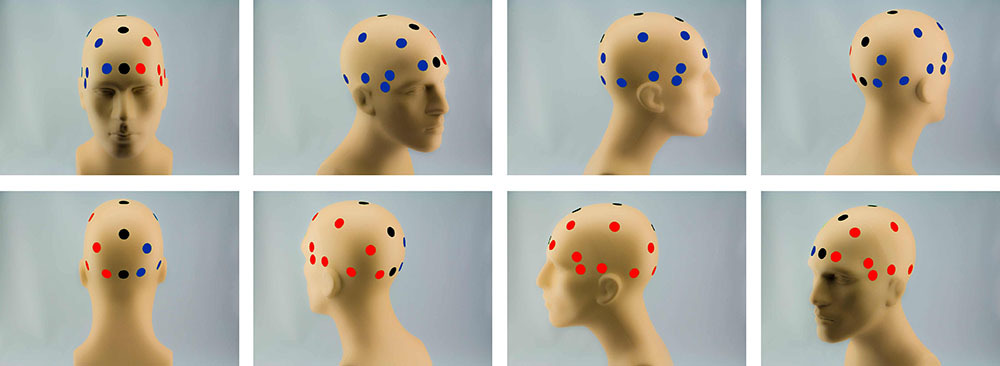
TDCS - transcranial stimulation with direct current - works as follows. Two electrodes are attached to specific areas of the head - a positively charged anode and a negatively charged cathode. The anode acts on the neurons of the cortex stimulatingly, reducing the potential difference across their membranes. On the scale of the brain, such an impact leads to a local increase in the activity of the zone above which it is located. However, studies are now emerging that demonstrate that the action of tDCS is more widespread and affects some other areas of the brain that are functionally related to the stimulated area. In the case of a cathode, the excitability of neurons, on the contrary, decreases.
To date, several thousand tDCS research studies have been conducted, among which about 500-600 are on healthy volunteers. The stimulation parameters in them are very similar; they are effected by a direct current of 1-2 milliamperes for 20-30 minutes a day, from 1 to 10 consecutive days. However, as for the areas of the brain that are affected, there is a very large variety of options, in which at first you just get lost. Therefore, the task was to find areas of the brain, the electrical stimulation of which would lead to significant cognitive improvements repeated in several scientific studies.
To begin, I decided to comment on several areas of the location of the electrodesmost popular among representatives of the DIY community. I took the zones prepared by the Russian startup Brainstorm as a basis .
Number 1. Location of the DARPA electrodes - to improve the reaction and concentration of attention.
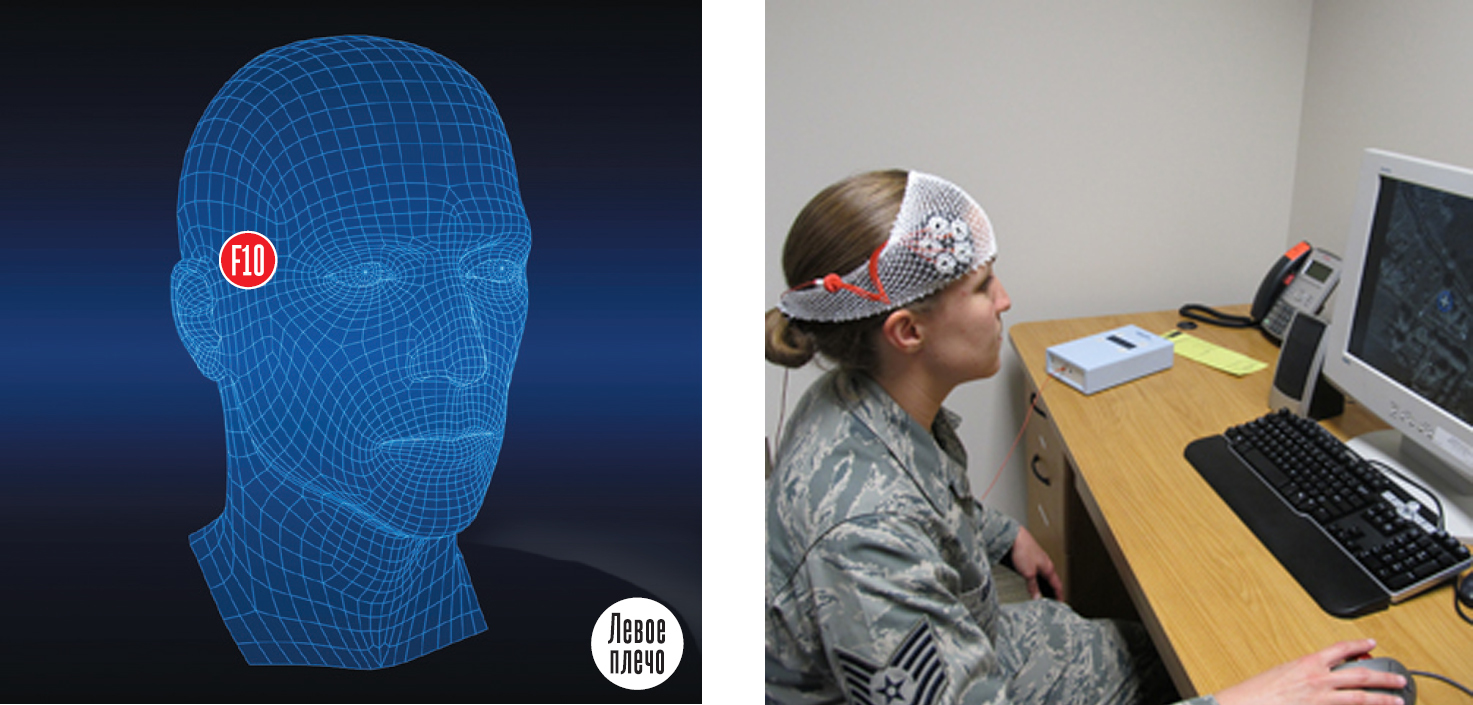
When the DARPA electrodes are located, the anode (excitation electrode) is applied to the right temple, and the cathode (inhibiting electrode) to the left shoulder. The electrical stimulation of this area was first carried out by the US defense agency DARPA in order to speed up military training before being sent to hot spots. Scientists first talked about their results in 2008 at the “Operational neuroscience - Intelligence community forum” conference, where they made a splash, showing that tDCS accelerated the training of volunteers 2.1 times! And after 4 years came outscientific article with a detailed description of the results of their research.

The experiment was conducted on 96 healthy volunteers who were trained on the video simulator "DARWARS Ambush!". This is a game specially designed for the training of American infantry and requiring a high concentration of attention and reaction. Participants walk through virtual landscapes and discover danger among dilapidated houses and abandoned cars, as well as search for explosive devices and enemy militants. During training, some people were stimulated with a weak current, and in people from the placebo group, the tDCS group was simulated so that they did not doubt that they were also being stimulated.
The results of the experiment turned out to be impressive: tDCS reduced the time of training, which a beginner needs to become a professional, by 2.1 times (this is just a huge effect, compared to ordinary biological effects). And, not least, people who underwent tDCS lost their skills much slower compared to the control group.
Interestingly, in order to select a zone for stimulation, scientists studied patterns of brain activation in beginners and professionals using functional MRI. It turned out that during the execution of a task for beginners, the excitation of various parts of the brain occurs, while the professionals activate a strictly defined area in the region of the right temple. It is on this area that the scientists decided to locate the "exciting" anode.

Then, the US military began to use tDCS to improve pilot training on video simulators. In 2011, at the Society for Neuroscience annual meeting conference, they reported that they had managed to achieve a 2-fold increase in the rate of acquisition of new skills. And, importantly, the effect of tDCS persisted for a long time after the procedure was terminated.
It is important to note that the sensations from tDCS are rather neutral and are not accompanied by a feeling of acceleration or euphoria. One of the volunteers said that "I felt a tickling and a slight burning sensation at the place of attachment of the electrodes." And after the first tDCS sessions, a slight dizziness or feeling of fatigue is sometimes even observed.

Subsequently, several more scientific studies were conducted on the electrical stimulation of the right temporal region, which confirmed the effect of tDCS on training. For example, the results were repeated in a double-blind, placebo-controlled trial (prior to this, the studies were single-blind). In addition, it was independently shown that the effect of a single tDCS session lasts for at least one more day.
A whole range of scientific researchdemonstrates that tDCS affects another cognitive function - inhibitory control. Behavioral inhibition is extremely important for the effective execution of tasks, as it allows you to control and suppress the urges that interfere with the execution of the current task. For example, if you are attending a dinner party, even if you are very hungry, you can still eat slowly and even stop if someone turns to you (or the taste of food seems strange to you).
In all these studies, electrical stimulation contributed to enhancing cognitive control, which, apparently, can have a positive effect on learning, making it possible not to be distracted from the main task for external stimuli.
Thus, the arrangement of the “DARPA” electrodes has been scientifically confirmed to accelerate learning, reaction and inhibitor control, but I have one comment about the location of the cathode. It is proposed to apply it to the left shoulder so that it does not exert an inactivating effect on the nervous tissue. However, among researchers there is an opinion that for these purposes it is more efficient to locate the cathode on the crown, cheek or area above the eye, which are also considered “inactive” zones.
Number 2. Location of electrodes to improve motor learning.
Location of electrodes for improving motor learning is different in the case of active right and left hands.
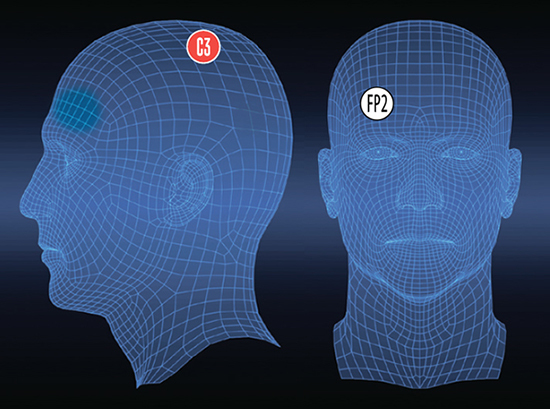
In right-handed anode is placed over the left motor cortex, and the cathode is located on the right brow brow area.

For left-handers, the location of the electrodes is the opposite: the anode is located above the right motor cortex, and the cathode is located on the left brow region.
Improving motor learning is perhaps leading the number of tDCS studies. This is due to the fact that such an effect is actively used in medicine, for example, when recovering from a stroke and to improve motor activity in old age. But even healthy people have been held for at least 7 double-blind, placebo-controlled study , in which tDCS improved motor learning adult volunteers . In all articles, the impact was carried out on the motor cortex.
In most studies, electrical stimulation was used to improve fine motor skills. In everyday life, this is the ability to quickly and accurately type text on the keyboard, control the mouse, play the piano, and “sleight of hand” in principle. And in scientific research tests are used in which you need to quickly respond to what is happening on the screen with the help of precise finger movements. For example, when a signal appears in a specific place in the monitor, you need to press the corresponding key on the keyboard. Or, by changing the force of pressing the sensor, you need to move the cursor on the screen and get into the “gate” (task “SVIPT”).
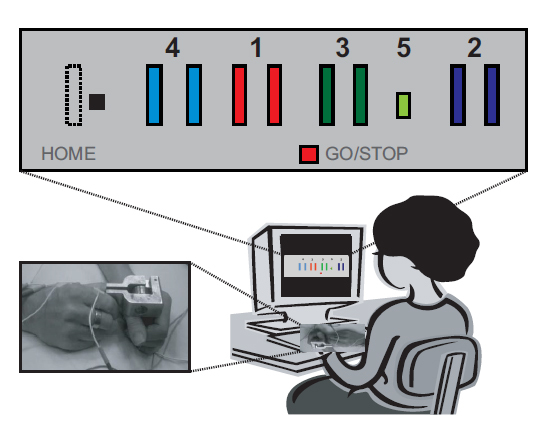
If tDCS is performed during such tasks , then the speed of performance is significantly increased, and the number of errors made decreases as compared with the placebo group.
Electrical stimulation can improve other motor skills, for example, sensory-motor adaptation. It is the ability to adjust movements in accordance with incoming visual or tactile signals, for example, while driving a car or when performing tricks in football and basketball. The criterion of sensory-motor adaptation in neurobiology is the effect of a “broken escalator”. First, a person stands on a moving escalator, and then - on the stopped. And if he stumbles while doing so, then his sensory-motor adaptation is at a normal level. Interestingly, the use of tDCS led to the fact that the “stumbling” effect became more pronounced, indicating an increase in adaptation.
Thus, electrical stimulation can simultaneously improve several different motor functions; the only thing I would like to note is that the effect from a single tDCS session may be statistically significant, but at the same time weak. However, when using electrical stimulation at least 3-5 days in a row, the result becomes much more pronounced. The diagram below shows the dynamics of training in the task for fine motor skills, showing that the difference between stimulation and placebo control increases with time and becomes most noticeable on the 5th day of training. By the way, in this study, the effect of electrostimulation was also long lasting for 3 months.

Number 3. The location of the electrodes to improve the learning of foreign languages
To improve the ability of foreign languages, the exciting electrode (anode) is recommended to be placed over the left prefrontal cortex, and the inhibiting electrode (cathode) - to the right supraorbital region. This arrangement of electrodes was used in at least 4 studies on healthy volunteers . True, in all these articles they looked only at a limited number of language parameters: fluency and associative linguistic thinking.
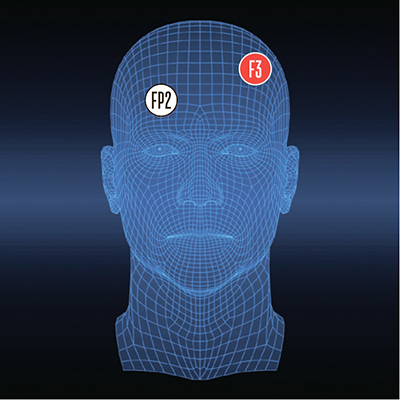
To assess the fluency of speech, we used tasks in which we need to recall as many words as possible, starting with a letter or belonging to a certain category (for example, “fruits”). And to evaluate creative language thinking, a test was used in which 3 words are given (for example, “childish” - “scan” - “wash”) and you need to come up with one more word as soon as possible that unites them (for example, “brain”) . Electrical stimulation improved all these indicators, but the effect was quite moderate. For example, the graph below (taken from a 2012 study ) shows that tDCS increased speech fluency by 6.6%, compared to imitation of stimulation (red bar).

In addition, I noticed that in addition to the prefrontal cortex, in order to improve language skills, the Wernicke zone is also an area responsible for the processing of speech information. This, in my opinion, is even more promising since the electrical stimulation of this zone affects the parameters that are crucial for language learning: the ability to memorize new foreign words and translate them into their native language.
For example, in 2008, German scientists conducted a double-blind, placebo-controlled study that accelerated learning a fictional foreign language with tDCS. Volunteers were subjected to one of the 3 types of stimulation: the impact of the anode or cathode on the Wernicke region or - placebo stimulation.
During tDCS, the subjects memorized new words of a non-existent language, and then performed tests in which they had to determine whether the picture was correctly signed and also to translate the newly learned words into their native German. It turned out that after the electrostimulation, people made much fewer mistakes in the tasks and translated the words from one language to another more quickly (compared to both control groups). Below is the location of electrodes for stimulating the Wernicke zone:
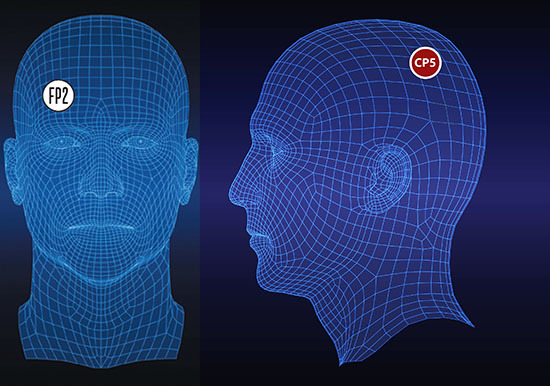
Number 4. Electrode arrangement for improving memory and attention
In order to improve memory and attentiveness, it is proposed to position the anode on the left dorsolateral prefrontal cortex and the cathode on the right shoulder. However, I note immediately that, in the opinionsome researchers, the location of the cathode on the shoulder is less effective than on the crown or superciliary area. I wrote about this above.
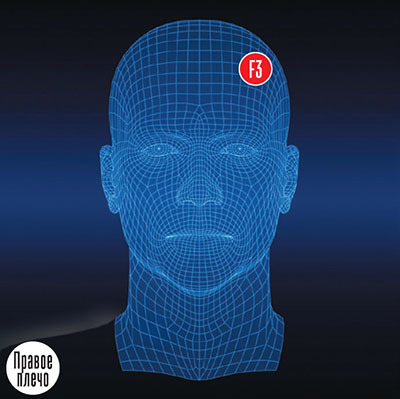
At least 8 scientific articles are devoted to improving memory through electrostimulation . About half of the studies are double-blind, placebo-controlled, and the second is “single-double” blind. It turns out that this is the name of the experiments in which “blinding” is performed on the subjects as well as on those who evaluate the data; however, not those who apply electrodes. In my opinion, in this case it does not play a big role, because the subjects during the study do not interact with the experimenters, but perform tasks in front of the computer monitor.
Studies show that tDCS affects working memory — the ability to “keep in mind” the small pieces of information needed for momentary activity. Evaluate the working memory most often with the help of the "n-back" test - tasks in which different pictures appear on the screen in succession, and it is necessary to determine whether the image is the same as the "n" positions backwards. There are various variations of this test, where you need to remember a picture that was 1, 2, 3 or 4 positions back.
Most electrostimulation studies use the “2-back task”. A meta-analysis of 8 studies showed that tDCS increases the speed at which volunteers give an answer in such a task, but does not change the accuracy of the answers. However, if you use more complex tests, for example, “ 3-back task"Or" 4-back task ", then tDCS not only increases the speed of the task, but also reduces the number of errors.
There is evidence that exposure to the left prefrontal cortex can also improve concentration . And US military studies have demonstrated that tDCS in this zone helps maintain performance in conditions of chronic lack of sleep. Employees of the military base, who did not sleep for 30 hours in a row, were divided into 3 groups. People from the first group were electrostimulated, in the second - imitated, and in the third - imitated and allowed to drink coffee.
It turned out that the half-hour stimulation helped to increase productivity by 2 times better than caffeine, and the effect lasted 3 times longer. After 4 hours, those who received electrical stimulation correctly performed 60% of tasks, while people who drank coffee only 30%. According to subjective feelings, people undergoing tDCS felt less tired and sleepy and were more energetic.
However, despite the encouraging results of scientific research, scientists are apprehensiverelate to the independent use of tDCS. Firstly, there is a danger that a person will misplace the electrodes, which is fraught with a deterioration in cognitive function instead of improving it. In addition, there is a danger that he will spend tDCS longer than 20 minutes, which is also undesirable. Well, in no scientific study tDCS spend more than 2 weeks in a row. Therefore, experts have no idea what will happen if someone starts to affect the brain with electricity every day for several years.
However, commercial manufacturers have been producing portable devices for personal use for 5 years. Interestingly, many people choose only one zone of some kind and make an instrument with a fixed arrangement of electrodes. For example, this was the first version of foc.usfor gamers, electrodes were fixed on the forehead, and thync startup chose the location on the right temple. Devices that allow the electrodes to be placed on almost any area of the head and fixed with a bandage possess a much wider range of possibilities. For example, “ Thebrainstimulator ”, “ PriorMind ”, “ Brainstorm neurostimulator ”.
Such devices allow testing different electrode arrangements for various cognitive effects, although there remains a risk that in this case a person will make a mistake and place the electrodes incorrectly.
However, the key point for conducting electrostimulation is the right choice of places for attaching electrodes to the head. Indeed, the stimulation of various areas of the brain leads to fundamentally different cognitive effects - depending on the functions of these areas. Therefore, I decided to sort out scientific articles and find out which zones stimulation really leads to tangible cognitive improvements and what pitfalls can be here.

TDCS - transcranial stimulation with direct current - works as follows. Two electrodes are attached to specific areas of the head - a positively charged anode and a negatively charged cathode. The anode acts on the neurons of the cortex stimulatingly, reducing the potential difference across their membranes. On the scale of the brain, such an impact leads to a local increase in the activity of the zone above which it is located. However, studies are now emerging that demonstrate that the action of tDCS is more widespread and affects some other areas of the brain that are functionally related to the stimulated area. In the case of a cathode, the excitability of neurons, on the contrary, decreases.
To date, several thousand tDCS research studies have been conducted, among which about 500-600 are on healthy volunteers. The stimulation parameters in them are very similar; they are effected by a direct current of 1-2 milliamperes for 20-30 minutes a day, from 1 to 10 consecutive days. However, as for the areas of the brain that are affected, there is a very large variety of options, in which at first you just get lost. Therefore, the task was to find areas of the brain, the electrical stimulation of which would lead to significant cognitive improvements repeated in several scientific studies.
To begin, I decided to comment on several areas of the location of the electrodesmost popular among representatives of the DIY community. I took the zones prepared by the Russian startup Brainstorm as a basis .
Number 1. Location of the DARPA electrodes - to improve the reaction and concentration of attention.

When the DARPA electrodes are located, the anode (excitation electrode) is applied to the right temple, and the cathode (inhibiting electrode) to the left shoulder. The electrical stimulation of this area was first carried out by the US defense agency DARPA in order to speed up military training before being sent to hot spots. Scientists first talked about their results in 2008 at the “Operational neuroscience - Intelligence community forum” conference, where they made a splash, showing that tDCS accelerated the training of volunteers 2.1 times! And after 4 years came outscientific article with a detailed description of the results of their research.

The experiment was conducted on 96 healthy volunteers who were trained on the video simulator "DARWARS Ambush!". This is a game specially designed for the training of American infantry and requiring a high concentration of attention and reaction. Participants walk through virtual landscapes and discover danger among dilapidated houses and abandoned cars, as well as search for explosive devices and enemy militants. During training, some people were stimulated with a weak current, and in people from the placebo group, the tDCS group was simulated so that they did not doubt that they were also being stimulated.
The results of the experiment turned out to be impressive: tDCS reduced the time of training, which a beginner needs to become a professional, by 2.1 times (this is just a huge effect, compared to ordinary biological effects). And, not least, people who underwent tDCS lost their skills much slower compared to the control group.
Interestingly, in order to select a zone for stimulation, scientists studied patterns of brain activation in beginners and professionals using functional MRI. It turned out that during the execution of a task for beginners, the excitation of various parts of the brain occurs, while the professionals activate a strictly defined area in the region of the right temple. It is on this area that the scientists decided to locate the "exciting" anode.

Then, the US military began to use tDCS to improve pilot training on video simulators. In 2011, at the Society for Neuroscience annual meeting conference, they reported that they had managed to achieve a 2-fold increase in the rate of acquisition of new skills. And, importantly, the effect of tDCS persisted for a long time after the procedure was terminated.
It is important to note that the sensations from tDCS are rather neutral and are not accompanied by a feeling of acceleration or euphoria. One of the volunteers said that "I felt a tickling and a slight burning sensation at the place of attachment of the electrodes." And after the first tDCS sessions, a slight dizziness or feeling of fatigue is sometimes even observed.

Subsequently, several more scientific studies were conducted on the electrical stimulation of the right temporal region, which confirmed the effect of tDCS on training. For example, the results were repeated in a double-blind, placebo-controlled trial (prior to this, the studies were single-blind). In addition, it was independently shown that the effect of a single tDCS session lasts for at least one more day.
A whole range of scientific researchdemonstrates that tDCS affects another cognitive function - inhibitory control. Behavioral inhibition is extremely important for the effective execution of tasks, as it allows you to control and suppress the urges that interfere with the execution of the current task. For example, if you are attending a dinner party, even if you are very hungry, you can still eat slowly and even stop if someone turns to you (or the taste of food seems strange to you).
In all these studies, electrical stimulation contributed to enhancing cognitive control, which, apparently, can have a positive effect on learning, making it possible not to be distracted from the main task for external stimuli.
Thus, the arrangement of the “DARPA” electrodes has been scientifically confirmed to accelerate learning, reaction and inhibitor control, but I have one comment about the location of the cathode. It is proposed to apply it to the left shoulder so that it does not exert an inactivating effect on the nervous tissue. However, among researchers there is an opinion that for these purposes it is more efficient to locate the cathode on the crown, cheek or area above the eye, which are also considered “inactive” zones.
Number 2. Location of electrodes to improve motor learning.
Location of electrodes for improving motor learning is different in the case of active right and left hands.

In right-handed anode is placed over the left motor cortex, and the cathode is located on the right brow brow area.

For left-handers, the location of the electrodes is the opposite: the anode is located above the right motor cortex, and the cathode is located on the left brow region.
Improving motor learning is perhaps leading the number of tDCS studies. This is due to the fact that such an effect is actively used in medicine, for example, when recovering from a stroke and to improve motor activity in old age. But even healthy people have been held for at least 7 double-blind, placebo-controlled study , in which tDCS improved motor learning adult volunteers . In all articles, the impact was carried out on the motor cortex.
In most studies, electrical stimulation was used to improve fine motor skills. In everyday life, this is the ability to quickly and accurately type text on the keyboard, control the mouse, play the piano, and “sleight of hand” in principle. And in scientific research tests are used in which you need to quickly respond to what is happening on the screen with the help of precise finger movements. For example, when a signal appears in a specific place in the monitor, you need to press the corresponding key on the keyboard. Or, by changing the force of pressing the sensor, you need to move the cursor on the screen and get into the “gate” (task “SVIPT”).

If tDCS is performed during such tasks , then the speed of performance is significantly increased, and the number of errors made decreases as compared with the placebo group.
Electrical stimulation can improve other motor skills, for example, sensory-motor adaptation. It is the ability to adjust movements in accordance with incoming visual or tactile signals, for example, while driving a car or when performing tricks in football and basketball. The criterion of sensory-motor adaptation in neurobiology is the effect of a “broken escalator”. First, a person stands on a moving escalator, and then - on the stopped. And if he stumbles while doing so, then his sensory-motor adaptation is at a normal level. Interestingly, the use of tDCS led to the fact that the “stumbling” effect became more pronounced, indicating an increase in adaptation.
Thus, electrical stimulation can simultaneously improve several different motor functions; the only thing I would like to note is that the effect from a single tDCS session may be statistically significant, but at the same time weak. However, when using electrical stimulation at least 3-5 days in a row, the result becomes much more pronounced. The diagram below shows the dynamics of training in the task for fine motor skills, showing that the difference between stimulation and placebo control increases with time and becomes most noticeable on the 5th day of training. By the way, in this study, the effect of electrostimulation was also long lasting for 3 months.

Number 3. The location of the electrodes to improve the learning of foreign languages
To improve the ability of foreign languages, the exciting electrode (anode) is recommended to be placed over the left prefrontal cortex, and the inhibiting electrode (cathode) - to the right supraorbital region. This arrangement of electrodes was used in at least 4 studies on healthy volunteers . True, in all these articles they looked only at a limited number of language parameters: fluency and associative linguistic thinking.

To assess the fluency of speech, we used tasks in which we need to recall as many words as possible, starting with a letter or belonging to a certain category (for example, “fruits”). And to evaluate creative language thinking, a test was used in which 3 words are given (for example, “childish” - “scan” - “wash”) and you need to come up with one more word as soon as possible that unites them (for example, “brain”) . Electrical stimulation improved all these indicators, but the effect was quite moderate. For example, the graph below (taken from a 2012 study ) shows that tDCS increased speech fluency by 6.6%, compared to imitation of stimulation (red bar).

In addition, I noticed that in addition to the prefrontal cortex, in order to improve language skills, the Wernicke zone is also an area responsible for the processing of speech information. This, in my opinion, is even more promising since the electrical stimulation of this zone affects the parameters that are crucial for language learning: the ability to memorize new foreign words and translate them into their native language.
For example, in 2008, German scientists conducted a double-blind, placebo-controlled study that accelerated learning a fictional foreign language with tDCS. Volunteers were subjected to one of the 3 types of stimulation: the impact of the anode or cathode on the Wernicke region or - placebo stimulation.
During tDCS, the subjects memorized new words of a non-existent language, and then performed tests in which they had to determine whether the picture was correctly signed and also to translate the newly learned words into their native German. It turned out that after the electrostimulation, people made much fewer mistakes in the tasks and translated the words from one language to another more quickly (compared to both control groups). Below is the location of electrodes for stimulating the Wernicke zone:

Number 4. Electrode arrangement for improving memory and attention
In order to improve memory and attentiveness, it is proposed to position the anode on the left dorsolateral prefrontal cortex and the cathode on the right shoulder. However, I note immediately that, in the opinionsome researchers, the location of the cathode on the shoulder is less effective than on the crown or superciliary area. I wrote about this above.

At least 8 scientific articles are devoted to improving memory through electrostimulation . About half of the studies are double-blind, placebo-controlled, and the second is “single-double” blind. It turns out that this is the name of the experiments in which “blinding” is performed on the subjects as well as on those who evaluate the data; however, not those who apply electrodes. In my opinion, in this case it does not play a big role, because the subjects during the study do not interact with the experimenters, but perform tasks in front of the computer monitor.
Studies show that tDCS affects working memory — the ability to “keep in mind” the small pieces of information needed for momentary activity. Evaluate the working memory most often with the help of the "n-back" test - tasks in which different pictures appear on the screen in succession, and it is necessary to determine whether the image is the same as the "n" positions backwards. There are various variations of this test, where you need to remember a picture that was 1, 2, 3 or 4 positions back.
Most electrostimulation studies use the “2-back task”. A meta-analysis of 8 studies showed that tDCS increases the speed at which volunteers give an answer in such a task, but does not change the accuracy of the answers. However, if you use more complex tests, for example, “ 3-back task"Or" 4-back task ", then tDCS not only increases the speed of the task, but also reduces the number of errors.
There is evidence that exposure to the left prefrontal cortex can also improve concentration . And US military studies have demonstrated that tDCS in this zone helps maintain performance in conditions of chronic lack of sleep. Employees of the military base, who did not sleep for 30 hours in a row, were divided into 3 groups. People from the first group were electrostimulated, in the second - imitated, and in the third - imitated and allowed to drink coffee.
It turned out that the half-hour stimulation helped to increase productivity by 2 times better than caffeine, and the effect lasted 3 times longer. After 4 hours, those who received electrical stimulation correctly performed 60% of tasks, while people who drank coffee only 30%. According to subjective feelings, people undergoing tDCS felt less tired and sleepy and were more energetic.
However, despite the encouraging results of scientific research, scientists are apprehensiverelate to the independent use of tDCS. Firstly, there is a danger that a person will misplace the electrodes, which is fraught with a deterioration in cognitive function instead of improving it. In addition, there is a danger that he will spend tDCS longer than 20 minutes, which is also undesirable. Well, in no scientific study tDCS spend more than 2 weeks in a row. Therefore, experts have no idea what will happen if someone starts to affect the brain with electricity every day for several years.
However, commercial manufacturers have been producing portable devices for personal use for 5 years. Interestingly, many people choose only one zone of some kind and make an instrument with a fixed arrangement of electrodes. For example, this was the first version of foc.usfor gamers, electrodes were fixed on the forehead, and thync startup chose the location on the right temple. Devices that allow the electrodes to be placed on almost any area of the head and fixed with a bandage possess a much wider range of possibilities. For example, “ Thebrainstimulator ”, “ PriorMind ”, “ Brainstorm neurostimulator ”.
Such devices allow testing different electrode arrangements for various cognitive effects, although there remains a risk that in this case a person will make a mistake and place the electrodes incorrectly.
